内蒙古农业大学:《分子生物学》课程教学资源(自编教材)英文版分子生物学

内蒙古农业大学 英汉双语教学辅助教材 分子生物学选读 李国婧周欢敏主编 内蒙古农业大学教务处 二OO八年三月
内蒙古农业大学 英汉双语教学辅助教材 分子生物学选读 李国婧 周欢敏 主编 内蒙古农业大学教务处 二〇〇八年三月
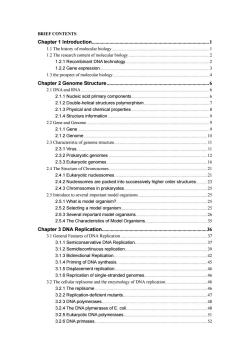
BRIEF CONTENTS Chapter 1 Introduction. 11 The history of molecular biology 1 2 The res rch content of molecular biolog 1.2.1 Recombinant DNA technology 1.2.2 Gene expression. 1.3 the prospect of molecular biology Chapter 2 Genome Structure. 6 2.1 DNA and RNA. .6 2.1.1 Nucleic acid primary components. 6 2.1.2 Double-helical structures polymorphism. 7 2.1.3 Physical and che ical properties Q 2.1.4 Structure information 2.2 Gene and Genome. 2.1.1 Gene 9 2 1 2 Genome 10 23Characteristic of genome structur 11 2.3.1Virus 2.3.2 Prokaryotic genomes. 2.3.3 Eukarvotic genomes. .16 2 4 The Structure of chromosomes 21 2.4.1 Eukaryotic nucleosomes 1 2.4.2 Nuceosomes are packed into successively higher order structures 23 2.4.3 Chromosomes in prokaryotes. 2.5 Introduce to several important model organisms. .25 2.5.1 What is model organism?. 25 2.5.2 Selecting a model organism 75 2.5.3 Several imp tant 2.5.4 The Characteristics of 35 Chapter 3 DNA Replication 31。 atures of DNA Rep licatior 37 37 3.1.2 Semidiscontinuous replication. .39 3 1 3 Bidirectional replication 42 3.1.4 Priming of DNA synthesis. 3.1.5 Displa 46 3.1.6 Reprication of single-stranded genomes 3.2 The cellular replisome and the enzymology of DNA replication. .46 3.2.1 The replisome 46 3.2.2 Replication-deficient mutants. 47 3.2.3 DNApolymerases 48 3.2.4 The DNAplymerases of E.coli .48 3.2.5 Eukaryotic DNA polymerases. .5 3.2.6 DNA primases. .52
BRIEF CONTENTS Chapter 1 Introduction.1 1.1 The history of molecular biology.1 1.2 The research content of molecular biology .2 1.2.1 Recombinant DNA technology.2 1.2.2 Gene expression.3 1.3 the prospect of molecular biology.4 Chapter 2 Genome Structure .6 2.1 DNA and RNA .6 2.1.1 Nucleic acid primary components .6 2.1.2 Double-helical structures polymorphism.7 2.1.3 Physical and chemical properties .8 2.1.4 Structure information.9 2.2 Gene and Genome.9 2.1.1 Gene.9 2.1.2 Genome .10 2.3 Characteristic of genome structure.11 2.3.1 Virus.11 2.3.2 Prokaryotic genomes .12 2.3.3 Eukaryotic genomes.16 2.4 The Structure of Chromosomes.21 2.4.1 Eukaryotic nucleosomes.21 2.4.2 Nucleosomes are packed into successively higher order structures.23 2.4.3 Chromosomes in prokaryotes.25 2.5 Introduce to several important model organisms .25 2.5.1 What is model organism?.25 2.5.2 Selecting a model organism.25 2.5.3 Several important model organisms .26 2.5.4 The Characteristics of Model Organisms.35 Chapter 3 DNA Replication.36 3.1 General Features of DNA Replication .37 3.1.1 Semiconservative DNA Replication.37 3.1.2 Semidiscontinuous replication.39 3.1.3 Bidirectional Replication. .42 3.1.4 Priming of DNA synthesis. .45 3.1.5 Displacement replication. .46 3.1.6 Reprication of single-stranded genomes. .46 3.2 The cellular replisome and the enzymology of DNA replication.46 3.2.1 The replisome .46 3.2.2 Replication-deficient mutants.47 3.2.3 DNA polymerases.48 3.2.4 The DNA plymerases of E. coli.48 3.2.5 Eukaryotic DNA polymerases.51 3.2.6 DNA primases. .52
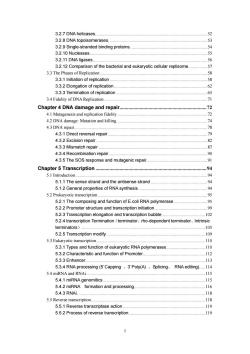
32 7 DNA helicases 52 3.2.8 DNA topoisomerases. 53 3.2.9Single-stra nded binding proteins 32.10N ases 3.2.11 DNA ligases. 3.2.12 Comparison of the bacterial and eukarvotic cellular replisome. 57 33 The Phases of Replication. 58 3.3.1 Initiation of replication 3.3.2 Elongation of replication 62 3.3.3 Termination of replication 6 3.4 Fidelity of DNA Replication. .71 Chapter 4 DNA damage and repair 72 4.1 Mutagenesis and replication fidelity 72 4.2 DNA damage:Mutation and killing 74 4.3 DNA repair. 7 4.3.1 irect reversal repair 70 4.3.2 Excision repair .82 4.3.3 Mismatch repair. .87 4.3.4 Recombination repair. 90 4.3.5 The SOS response and mutagenic repair 01 Chapter 5 Transcription. 94 5.1 Introduction. 04 5.1.1 The sense strand and the antisense strand 04 5.1.2 General properties of RNA synthesis. 5.2 Prokaryotic transcription. .95 5.2.1 The composing and function of E.coli RNA polymerase .95 5.2.2 Promoter structure and transcription initiation 5.2.3 Transcription elongation and transcription bubble 102 5 2 4 tra iption Ter ator hn depen inator.Intrinsic terminators) 5.2.5 Transcription modify ,.109 5 3 Eukarvotic transcription 110 5.3.1 Types and function of eukaryotic RNA polymerases 110 5.3.2 Characteristic and function of Promote 112 5.3.3 Enhancer 5.3.4 RNA processing (5 Capping,3'Poly(A)Splicing.RNA editing).114 5.4 miRNA and RNAi. ,115 5 4 1 miRNA genomitics 115 5.4.2 miRNA formation and processing 116 5.4.3RNAi. 118 5.5 Reverse transcription. 5.5.1 Reverse transcriptase action. 119 5.5.2 Process of reverse transcription. .119
5 3.2.7 DNA helicases.52 3.2.8 DNA topoisomerases.53 3.2.9 Single-stranded binding proteins. .54 3.2.10 Nucleases.55 3.2.11 DNA ligases.56 3.2.12 Comparison of the bacterial and eukaryotic cellular replisome.57 3.3 The Phases of Replication.58 3.3.1 Initiation of replication .58 3.3.2 Elongation of replication .62 3.3.3 Termination of replication .65 3.4 Fidelity of DNA Replication .71 Chapter 4 DNA damage and repair.72 4.1 Mutagenesis and replication fidelity .72 4.2 DNA damage: Mutation and killing.74 4.3 DNA repair.78 4.3.1 Direct reversal repair.79 4.3.2 Excision repair.82 4.3.3 Mismatch repair .87 4.3.4 Recombination repair.90 4.3.5 The SOS response and mutagenic repair.91 Chapter 5 Transcription .94 5.1 Introduction.94 5.1.1 The sense strand and the antisense strand .94 5.1.2 General properties of RNA synthesis .94 5.2 Prokaryotic transcription.95 5.2.1 The composing and function of E.coli RNA polymerase .95 5.2.2 Promoter structure and transcription initiation .99 5.2.3 Transcription elongation and transcription bubble.102 5.2.4 transcription Termination(terminator、rho-dependent terminator、Intrinsic terminators).105 5.2.5 Transcription modify .109 5.3 Eukaryotic transcription.110 5.3.1 Types and function of eukaryotic RNA polymerases.110 5.3.2 Characteristic and function of Promoter.112 5.3.3 Enhancer.113 5.3.4 RNA processing (5`Capping 、3`Poly(A) 、Splicing、 RNA editing).114 5.4 miRNA and RNAi.115 5.4.1 miRNA genomitics .115 5.4.2 miRNA formation and processing.116 5.4.3 RNAi. .118 5.5 Reverse transcription.118 5.5.1 Reverse transcriptase action .119 5.5.2 Process of reverse transcription.119
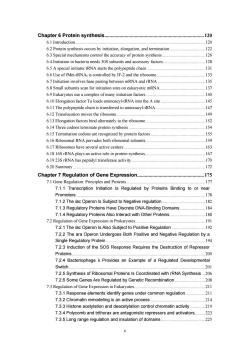
Chapter 6 Protein synthesis 120 6 1 Introduction .120 6 2 Protein synthesis occurs by initiation elongation and termination 122 6 3 Special mechanisms control the ac otein synthesis 126 accessory factors 128 6.5A special initiator tRNA starts the polypeptide chair 6.6 Use of fMet-tRNAr is controlled by IF-2 and the ribosome. 133 6.7 Initiation involves base pairing between mRNA and rRNA. .135 6.8 Small subunits scan for initiation sites on eukaryotic mRNA 137 Eukaryo ea co 140 6.10 Elongation factor Tu loads aminoacyl-tRNA into the A site 6.11 The polypeptide chain is transferred to aminoacyl-tRNA. .147 6 12 Translocation moves the ribosome 149 6.13 Elongation factors bind alternately to the ribosome 152 codons terminate protein synthesis 154 codons are recog nized by protein factors 6.16 Ribosomal RNA pervades both ribosomal subunits 13 6.17 Ribosomes have several active centers 163 6.18 16S rRNA plays an active role in protein synthesis 167 6.1923rRNA has peptidyl transferase activity 170 6.20 Summary. .12 Chapter 7 Regulation of Gene Expression 175 7.1Gene Regulatior inciples and Pr 17 7.1.1 Transcription Initiation Is Regulated by Proteins Binding to or nea Promoters. .178 7.1.2 The lac Operon Is Subject to Negative regulation. 182 7.1.3 Regulatory Proteins Have Discrete DNA-Binding Domains 184 7.1.4Reg Proteins Also Inte eract with Other Proteins 9 7.2.1 The lac Operon Is Also Subject to Positive Regulation 192 7.2.2 The ara Operon Undergoes Both Positive and Negative Regulation by a Single Regulatory Protein. 194 7.2.3 Induction of the SOS Response Requires the Destruction of Repressor Prot ins 10 7.2.4 Bacteriophage Provides an Example of a Regulated Developmental Switch. .201 7.2.5 Synthesis of Ribosomal Proteins Is Coordinated with rRNA Synthesis.206 7.2.6 Some genes are reaulated by genetic Recombination 208 73 Regulation of Gene Expression in Eukaryote 211 esponse elements ide ntify genes under common regulatior .211 7.3.2 Chromatin remodeling is an active process. .214 7.3.3 Histone acetylation and deacetylation control chromatin activity. .219 7.3.4 Polycomb and trithorax are antagonistic repressors and activators. 223 7.3.5 Long range regulation and insulation of dom ains 225
6 Chapter 6 Protein synthesis.120 6.1 Introduction.120 6.2 Protein synthesis occurs by initiation, elongation, and termination.122 6.3 Special mechanisms control the accuracy of protein synthesis.126 6.4 Initiation in bacteria needs 30S subunits and accessory factors.128 6.5 A special initiator tRNA starts the polypeptide chain.131 6.6 Use of fMet-tRNAf is controlled by IF-2 and the ribosome.133 6.7 Initiation involves base pairing between mRNA and rRNA.135 6.8 Small subunits scan for initiation sites on eukaryotic mRNA.137 6.9 Eukaryotes use a complex of many initiation factors.140 6.10 Elongation factor Tu loads aminoacyl-tRNA into the A site .145 6.11 The polypeptide chain is transferred to aminoacyl-tRNA.147 6.12 Translocation moves the ribosome.149 6.13 Elongation factors bind alternately to the ribosome.152 6.14 Three codons terminate protein synthesis .154 6.15 Termination codons are recognized by protein factors .155 6.16 Ribosomal RNA pervades both ribosomal subunits.159 6.17 Ribosomes have several active centers .163 6.18 16S rRNA plays an active role in protein synthesis.167 6.19 23S rRNA has peptidyl transferase activity .170 6.20 Summary .172 Chapter 7 Regulation of Gene Expression.175 7.1 Gene Regulation: Principles and Proteins.177 7.1.1 Transcription Initiation Is Regulated by Proteins Binding to or near Promoters .178 7.1.2 The lac Operon Is Subject to Negative regulation.182 7.1.3 Regulatory Proteins Have Discrete DNA-Binding Domains.184 7.1.4 Regulatory Proteins Also Interact with Other Proteins.188 7.2 Regulation of Gene Expression in Prokaryotes.191 7.2.1 The lac Operon Is Also Subject to Positive Regulation .192 7.2.2 The ara Operon Undergoes Both Positive and Negative Regulation by a Single Regulatory Protein .194 7.2.3 Induction of the SOS Response Requires the Destruction of Repressor Proteins.200 7.2.4 Bacteriophage λ Provides an Example of a Regulated Developmental Switch.201 7.2.5 Synthesis of Ribosomal Proteins Is Coordinated with rRNA Synthesis .206 7.2.6 Some Genes Are Regulated by Genetic Recombination .208 7.3 Regulation of Gene Expression in Eukaryotes.211 7.3.1 Response elements identify genes under common regulation.211 7.3.2 Chromatin remodeling is an active process .214 7.3.3 Histone acetylation and deacetylation control chromatin activity.219 7.3.4 Polycomb and trithorax are antagonistic repressors and activators.223 7.3.5 Long range regulation and insulation of domains.225
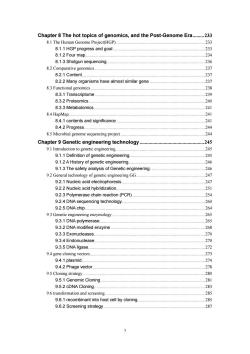
Chapter 8 The hot topics of genomics,and the Post-Genome Era.233 8.1 The Human Genome Proiect(HGP). .233 8.1.1 HGP progress and goal 233 8.1.2 Four map. )14 8.1.3 Shotgun sequencing 236 8 Comparative genomics. .237 8.2.1 Content. .237 8.2.2 Many organisms have almost similar gene. .237 8.3 Functional genomics. 238 8.3.1 Transcriptome 730 8.3.2 Proteomics 240 8.3.3 Metabolomics 241 84 HapMap 241 8.4.1 contents and significance 241 8.4.2 Progress. 344 5 Microbial genome sequencing project .24 Chapter 9 Genetic engineering technology .245 to gen tic engineering. 245 9.1.1 Definition of genetic engineering. 24 9.1.2 A History of genetic engineering. 246 9.1.3 The safety analysis of Genetic engineering. 246 9.2 General technology of genetic engineering GG 247 92 1 Nucleic 247 atior 5 9.2.3 Polymerase chain reaction(PCR) 254 9.2.4 DNA sequencing technology. 260 9.2.5 DNA chip. 264 9 3 genetic engine ing en☑y 365 9.3.1 DNA poly 265 9.3.2 DNA modified enzyme 9.3.3 Exonucleases. .270 9.3.4 Endonuclease 270 9.3.5 DNA ligase. 170 94g g ectors 273 9.4.2 Phage vector .278 9.5 Cloning strategy. .280 95 1 Genomic Cloning 281 9.5.2 cDNA Cloning. 7g3 9.6.1 recombinant into host cell by cloning. 28 9.6.2 Screening strategy 287
7 Chapter 8 The hot topics of genomics, and the Post-Genome Era.233 8.1 The Human Genome Project(HGP) .233 8.1.1 HGP progress and goal .233 8.1.2 Four map.234 8.1.3 Shotgun sequencing .236 8.2 Comparative genomics.237 8.2.1 Content.237 8.2.2 Many organisms have almost similar gene .237 8.3 Functional genomics .238 8.3.1 Transcriptome .239 8.3.2 Proteomics.240 8.3.3 Metabolomics .241 8.4 HapMap.241 8.4.1 contents and significance.241 8.4.2 Progress.244 8.5 Microbial genome sequencing project .244 Chapter 9 Genetic engineering technology .245 9.1 Introduction to genetic engineering.245 9.1.1 Definition of genetic engineering.245 9.1.2 A History of genetic engineering.246 9.1.3 The safety analysis of Genetic engineering. .246 9.2 General technology of genetic engineering GG.247 9.2.1 Nucleic acid electrophoresis.247 9.2.2 Nucleic acid hybridization.251 9.2.3 Polymerase chain reaction (PCR).254 9.2.4 DNA sequencing technology.260 9.2.5 DNA chip.264 9.3 Genetic engineering enzymology.265 9.3.1 DNA polymerase.265 9.3.2 DNA modified enzyme .268 9.3.3 Exonucleases.270 9.3.4 Endonuclease. .270 9.3.5 DNA ligase.272 9.4 gene cloning vectors.273 9.4.1 plasmid.274 9.4.2 Phage vector .278 9.5 Cloning strategy .280 9.5.1 Genomic Cloning .281 9.5.2 cDNA Cloning.283 9.6 transformation and screening .285 9.6.1 recombinant into host cell by cloning.285 9.6.2 Screening strategy .287

Chapter 1 Introduction In its earliest manifestations,molecular biology- -the name was coined by Warren Weaver of the Rockefeller Foundation of physical and chemica explanations of life rather than discipli ne.Following the advent of the Mendelian-chromosome theory of heredity in the 1910s and the maturation of atomic theory and quantum mechanics in the 1920s,such explanations seemed within reach.Weaver and others encouraged research at the intersection of and physics hile physicists suchas Nes Bohr and win Sch ger turne ed their attention to biologic spe ulation.However. the 1930s and 1940s it was by no means clear which-if any- -cross-disciplinary research would bear fruit:work in colloid chemistry.biophysics and radiation biology,crystallography,and other emerging fields all seemed promising.Between the molecules studied by chemists and the tiny structures visible under the optical microsco cellula omes,ther zone, world the ignore dimensions,"as it was called by the chemical-physicist Wolfgang Ostwald. 1.1 The history of molecular biology The history of molecular biology begins in the 1930s with the convergence of previo distinct ica discipline che try, genetics micrbioloy and virloay With the hops of inderstandins lifs at its most fundamental level,numerous physicists and chemists also took an interest in what would become molecular biology. In its modern sense,molecular biology attempts to explain the phenomena of life starting from then acr lecular properties that senerate th macromolecules in particular are the focus of the molecular biol logist 1)nucle acids,among which the most famous is deoxyribonucleic acid (or DNA),the constituent of genes,and 2)proteins,which are the active agents of living organisms. One definition of the scope of molecular biology therefore is to characterize the structure,function and relationships between these two This relatively limited definition will suffice to allov us to establ lish a date for the so-called "molecular revolution".or at least to establish a chronology of its mos fundamental developments In 1940 George Beadle and Edward Tatum demonstrated the existence of a precise relationship between genes and proteins.In the course of their experiments connect ng genetics with bioche nistry, ey switche the genetics mainst Drosophila to a more appropriate model organism,the fungus Neurospora,the construction and exploitation of new model organisms would become a recurring theme in the development of molecular biology.In 1944,Oswald Avery,working at the Rockefeller Institute of New York,demonstrated that genes are made up of DNA In 1952.Alfred Hershey and Martha Chase confirmed that the genetic material of the
1 Chapter 1 Introduction In its earliest manifestations, molecular biology—the name was coined by Warren Weaver of the Rockefeller Foundation in 1938—was an ideal of physical and chemical explanations of life, rather than a coherent discipline. Following the advent of the Mendelian-chromosome theory of heredity in the 1910s and the maturation of atomic theory and quantum mechanics in the 1920s, such explanations seemed within reach. Weaver and others encouraged research at the intersection of biology, chemistry and physics, while prominent physicists such as Niels Bohr and Erwin Schroedinger turned their attention to biological speculation. However, in the 1930s and 1940s it was by no means clear which—if any—cross-disciplinary research would bear fruit; work in colloid chemistry, biophysics and radiation biology, crystallography, and other emerging fields all seemed promising. Between the molecules studied by chemists and the tiny structures visible under the optical microscope, such as the cellular nucleus or the chromosomes, there was an obscure zone, “the world of the ignored dimensions,” as it was called by the chemical-physicist Wolfgang Ostwald. 1.1 The history of molecular biology The history of molecular biology begins in the 1930s with the convergence of various, previously distinct biological disciplines: biochemistry, genetics, microbiology, and virology. With the hope of understanding life at its most fundamental level, numerous physicists and chemists also took an interest in what would become molecular biology. In its modern sense, molecular biology attempts to explain the phenomena of life starting from the macromolecular properties that generate them. Two categories of macromolecules in particular are the focus of the molecular biologist: 1) nucleic acids, among which the most famous is deoxyribonucleic acid (or DNA), the constituent of genes, and 2) proteins, which are the active agents of living organisms. One definition of the scope of molecular biology therefore is to characterize the structure, function and relationships between these two types of macromolecules. This relatively limited definition will suffice to allow us to establish a date for the so-called "molecular revolution", or at least to establish a chronology of its most fundamental developments. In 1940, George Beadle and Edward Tatum demonstrated the existence of a precise relationship between genes and proteins. In the course of their experiments connecting genetics with biochemistry, they switched from the genetics mainstay Drosophila to a more appropriate model organism, the fungus Neurospora; the construction and exploitation of new model organisms would become a recurring theme in the development of molecular biology. In 1944, Oswald Avery, working at the Rockefeller Institute of New York, demonstrated that genes are made up of DNA. In 1952, Alfred Hershey and Martha Chase confirmed that the genetic material of the
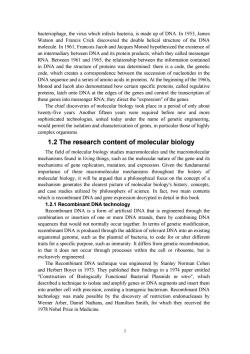
bacteriophage,the virus which infects bacteria,is made up of DNA.In 1953,James Watson and francis Crick discovered the double helical structure of the dna zed the existence of RNA.Between 1961 and 1965,the relationship between the information contained in DNA and the structure of proteins was determined:there is a code,the genetic code.which creates a correspondence between the succession of nucleotides in the DNA sec minoacids in.Atthe begin g of the 1960s Monod and Jacob also demonstrated how certain specific proteins proteins,latch onto DNA at the edges of the genes and control the transcription of these genes into messenger RNA;they direct the "expression"of the genes. The chief discoveries of molecular biology took place in a period of only abou ars.Another fifteen vear swere required before new and more technologies,united today under the name of genet engineering would permit the isolation and characterization of genes,in particular those of highly complex organisms. 1.2 The research content of molecular biology The field of molecular biology studies macromolecules and the macromolecula mechanisms found in living things,such as the molecular nature of the gene and its mechanisms of gene replication.mutation.and expression.Given the fundamental importance of these macromolecular mechanisms throughout the history of molecular biology,it will be argued that a philosophical focus on the concept of a mechanisn ates the clea est pictur of mole ular biolos ys history and utilized by philosophers of science.In main contents which s resombinant DNA and gene preion dooyp 1.2.1 Recombinant DNA technology Recombinant DNA is a form of artificial DNA that is engineered through the combination or insertion of one or more DNA strands,there by combining DNA sequ es that would not no cur together.In terms of modificatio recombinant DNA is produced through the addition of relevant DNA into an existing organismal genome,such as the plasmid of bacteria.to code for or alter different traits for a specific purpose,such as immunity.It differs from genetic recombination, in that it does not occur through processes within the cell or ribosome,but is exclusively en Th e Recombinant DNA technique was engineered by Stanley Norman Cohe and Herbert Boyer in 1973.They published their findings in a 1974 paper entitled "Construction of Biologically Functional Bacterial Plasmids in vitro",which described a technique to isolate and amplify genesor DNA segments and insert them into another cell with precision, eatin ansgenic bacterium.Recombinant DNA technology was made possible by the e discovery of restriction endonucleases Werner Arber,Daniel Nathans,and Hamilton Smith,for which they received the 1978 Nobel Prize in Medicine. 3
2 bacteriophage, the virus which infects bacteria, is made up of DNA. In 1953, James Watson and Francis Crick discovered the double helical structure of the DNA molecule. In 1961, Francois Jacob and Jacques Monod hypothesized the existence of an intermediary between DNA and its protein products, which they called messenger RNA. Between 1961 and 1965, the relationship between the information contained in DNA and the structure of proteins was determined: there is a code, the genetic code, which creates a correspondence between the succession of nucleotides in the DNA sequence and a series of amino acids in proteins. At the beginning of the 1960s, Monod and Jacob also demonstrated how certain specific proteins, called regulative proteins, latch onto DNA at the edges of the genes and control the transcription of these genes into messenger RNA; they direct the "expression" of the genes. The chief discoveries of molecular biology took place in a period of only about twenty-five years. Another fifteen years were required before new and more sophisticated technologies, united today under the name of genetic engineering, would permit the isolation and characterization of genes, in particular those of highly complex organisms. 1.2 The research content of molecular biology The field of molecular biology studies macromolecules and the macromolecular mechanisms found in living things, such as the molecular nature of the gene and its mechanisms of gene replication, mutation, and expression. Given the fundamental importance of these macromolecular mechanisms throughout the history of molecular biology, it will be argued that a philosophical focus on the concept of a mechanism generates the clearest picture of molecular biology's history, concepts, and case studies utilized by philosophers of science. In fact, two main contents which is recombinant DNA and gene expression decrypted in detail in this book. 1.2.1 Recombinant DNA technology Recombinant DNA is a form of artificial DNA that is engineered through the combination or insertion of one or more DNA strands, there by combining DNA sequences that would not normally occur together. In terms of genetic modification, recombinant DNA is produced through the addition of relevant DNA into an existing organismal genome, such as the plasmid of bacteria, to code for or alter different traits for a specific purpose, such as immunity. It differs from genetic recombination, in that it does not occur through processes within the cell or ribosome, but is exclusively engineered. The Recombinant DNA technique was engineered by Stanley Norman Cohen and Herbert Boyer in 1973. They published their findings in a 1974 paper entitled "Construction of Biologically Functional Bacterial Plasmids in vitro", which described a technique to isolate and amplify genes or DNA segments and insert them into another cell with precision, creating a transgenic bacterium. Recombinant DNA technology was made possible by the discovery of restriction endonucleases by Werner Arber, Daniel Nathans, and Hamilton Smith, for which they received the 1978 Nobel Prize in Medicine
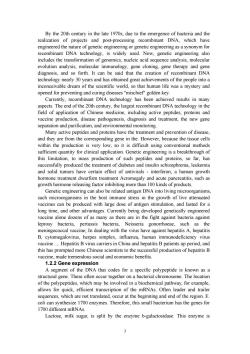
By the 20th century in the late 1970s.due to the emergence of bacteria and the realization of projects and post-processing recombinant DNA,which have engin ered the nature of genetic engineering or genetic engineering as a synonym fo recombinant DNA technology.is widely used.Now.genetic engineering also includes the transformation of genomics,nucleic acid sequence analysis,molecular evolution analysis.molecular immunology.gene cloning.gene therapy and gene diagnosis,and so forth.It can be said that the creation of recombinant DNA technology nearly 30 years and ha obtained great ach eveme of the people into inconceivable dream of the scientific world,so that human life was a mystery and opened for preventing and curing diseases"mischief"golden key. Currently,recombinant DNA technology has been achieved results in many 一s。h20 th centir,.eg以recombinan D technology inhe of Chines medi in ncluding active peptide proteins and vaccine production,disease pathogenesis,diagnosis and treatment,the new gene separation and purification,and environmental monitoring Many active peptides and proteins have the treatment and prevention of disease, and they are from the corresponding gene in the however.because the tissue cells within the production is low so it is difficult using onal methods ient quantity for application.Genetic engineering is a breakthrougho this limitation,to mass production of such peptides and proteins.so far.has successfully produced the treatment of diabetes and insulin schizophrenia,leukemia and solid tumors have certain effect of antivirals-interferon,a human growth hormone treatment dwarfism treatment Acro megaly and acute pancreatitis.such as growth ho e relea sing fact 1001k inds fproducts Genetic engineering can also be related antigen DNA into li ving mic oorganisms such microorganisms in the host immune stress in the growth of live attenuated vaccines can be produced with large dose of antigen stimulation,and lasted for a long time,and other advantages.Currently being developed genetically engineered cine alor ns of as s ther in the fight inst bacteria leprosy bacteria,pertussis Neisseria gonorrhoeae. such as the meningococcal vaccine;In dealing with the virus have against hepatitis A,hepatitis B,cytomegalovirus,herpes simplex,influenza,human immunodeficiency virus vaccine.Hepatitis B virus carriers in China and hepatitis B patients up period,and this has prom pted more Chinese scientists to the successful production of hepatitis B vacc ade tremendous cial and economic benefit 1.2.2 Gene expression A segment of the DNA that codes for a specific polypeptide is known as a structural gene.These often occur together on a bacterial chromosome.The location of the polypeptides,which may be involved in a biochemical pathway,for example, allows for qu uick,efficient tr ription of the mRNAs.Ofer der and tra sequences,which are not translated,occur at the beginning and end of the region.E coli can synthesize 1700 enzymes.Therefore,this small bacterium has the genes for 1700 different mRNAs. Lactose,milk sugar,is split by the enzyme b-galactosidase.This enzyme is 3
3 By the 20th century in the late 1970s, due to the emergence of bacteria and the realization of projects and post-processing recombinant DNA, which have engineered the nature of genetic engineering or genetic engineering as a synonym for recombinant DNA technology, is widely used. Now, genetic engineering also includes the transformation of genomics, nucleic acid sequence analysis, molecular evolution analysis, molecular immunology, gene cloning, gene therapy and gene diagnosis, and so forth. It can be said that the creation of recombinant DNA technology nearly 30 years and has obtained great achievements of the people into a inconceivable dream of the scientific world, so that human life was a mystery and opened for preventing and curing diseases "mischief" golden key. Currently, recombinant DNA technology has been achieved results in many aspects. The end of the 20th century, the largest recombinant DNA technology in the field of application of Chinese medicine, including active peptides, proteins and vaccine production, disease pathogenesis, diagnosis and treatment, the new gene separation and purification, and environmental monitoring. Many active peptides and proteins have the treatment and prevention of disease, and they are from the corresponding gene in the. However, because the tissue cells within the production is very low, so it is difficult using conventional methods sufficient quantity for clinical application. Genetic engineering is a breakthrough of this limitation, to mass production of such peptides and proteins, so far, has successfully produced the treatment of diabetes and insulin schizophrenia, leukemia and solid tumors have certain effect of antivirals - interferon, a human growth hormone treatment dwarfism treatment Acromegaly and acute pancreatitis, such as growth hormone releasing factor inhibiting more than 100 kinds of products. Genetic engineering can also be related antigen DNA into living microorganisms, such microorganisms in the host immune stress in the growth of live attenuated vaccines can be produced with large dose of antigen stimulation, and lasted for a long time, and other advantages. Currently being developed genetically engineered vaccine alone dozens of as many as there are in the fight against bacteria against leprosy bacteria, pertussis bacteria, Neisseria gonorrhoeae, such as the meningococcal vaccine; In dealing with the virus have against hepatitis A, hepatitis B, cytomegalovirus, herpes simplex, influenza, human immunodeficiency virus vaccine . Hepatitis B virus carriers in China and hepatitis B patients up period, and this has prompted more Chinese scientists to the successful production of hepatitis B vaccine, made tremendous social and economic benefits. 1.2.2 Gene expression A segment of the DNA that codes for a specific polypeptide is known as a structural gene. These often occur together on a bacterial chromosome. The location of the polypeptides, which may be involved in a biochemical pathway, for example, allows for quick, efficient transcription of the mRNAs. Often leader and trailer sequences, which are not translated, occur at the beginning and end of the region. E. coli can synthesize 1700 enzymes. Therefore, this small bacterium has the genes for 1700 different mRNAs. Lactose, milk sugar, is split by the enzyme b-galactosidase. This enzyme is
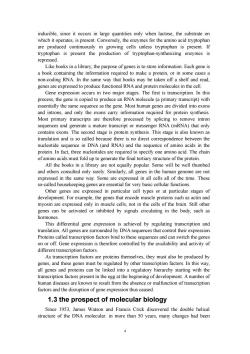
inducible,since it occurs in large quantities only when lactose,the substrate on which it operates,is present.Conversely,the enzymes for the amino acid tryptophan are produced continuously in growing ells unless trypte is present 1 tryptophan is present the production of tryptophan-synthesizing enzymes is repressed Like books in a library,the purpose of genes is to store information.Each gene is a book containing the information required to make a protein.or in some cases a non-coding RNA.In the same way that books may be taken off a shelf and read genes are expressed to produce functional RNA and protein molecules in the cell Gene expression occurs in two major stages.The first is transcription.In this process,the gene is copied to produce an RNA molecule(a primary transcript)with essentially the same sequence as the gene.Most human genes are divided into exons and introns,and only the exons carry information e processed by splicing to sequences and generate a mature transcript or messenger RNA(mRNA)that only contains exons.The second stage is protein synthesis.This stage is also known as translation and is so called because there is no direct correspondence between the nucleotide sequence in DNA(and RNA)and the sequence of amino acids in the protein.In fac thre nucleotides are require specify one amin acid.The chair of amino acids must fold up to generate the final tertiary structure of the protein All the books in a library are not equally popular.Some will be well thumbed and others consulted only rarely.Similarly,all genes in the human genome are not expressed in the same way.Some are expressed in all cells all of the time.These called hou ar tial for sic cellular functions Other gene are ex d in particular cel types or at particular stages of development.For example,the genes that encode muscle proteins such as actin and myosin are expressed only in muscle cells,not in the cells of the brain.Still other genes can be activated or inhibited by signals circulating in the body.such as hormones. This differential gene expres achieved by regulating scription and translation.All genes are surrounded by DNA sequences that control their expression Proteins called transcription factors bind to these sequences and can switch the genes on or off.Gene expression is therefore controlled by the availability and activity of different transcription factors. As tion factor e proteins themselves,they must also be produced by genes,and these genes must be regulated by other transcription factors.In this way all genes and proteins can be linked into a regulatory hierarchy starting with the transcription factors present in the egg at the beginning of development.A number of human diseases are known to result from the absence or malfunction of transcription factors and the disruption of gene expression thus caused. 1.3 the prospect of molecular biology Since 1953,James Watson and Francis Crick discovered the double helical structure of the DNA molecular.in more than 50 years,many changes had been
4 inducible, since it occurs in large quantities only when lactose, the substrate on which it operates, is present. Conversely, the enzymes for the amino acid tryptophan are produced continuously in growing cells unless tryptophan is present. If tryptophan is present the production of tryptophan-synthesizing enzymes is repressed. Like books in a library, the purpose of genes is to store information. Each gene is a book containing the information required to make a protein, or in some cases a non-coding RNA. In the same way that books may be taken off a shelf and read, genes are expressed to produce functional RNA and protein molecules in the cell. Gene expression occurs in two major stages. The first is transcription. In this process, the gene is copied to produce an RNA molecule (a primary transcript) with essentially the same sequence as the gene. Most human genes are divided into exons and introns, and only the exons carry information required for protein synthesis. Most primary transcripts are therefore processed by splicing to remove intron sequences and generate a mature transcript or messenger RNA (mRNA) that only contains exons. The second stage is protein synthesis. This stage is also known as translation and is so called because there is no direct correspondence between the nucleotide sequence in DNA (and RNA) and the sequence of amino acids in the protein. In fact, three nucleotides are required to specify one amino acid. The chain of amino acids must fold up to generate the final tertiary structure of the protein. All the books in a library are not equally popular. Some will be well thumbed and others consulted only rarely. Similarly, all genes in the human genome are not expressed in the same way. Some are expressed in all cells all of the time. These so-called housekeeping genes are essential for very basic cellular functions. Other genes are expressed in particular cell types or at particular stages of development. For example, the genes that encode muscle proteins such as actin and myosin are expressed only in muscle cells, not in the cells of the brain. Still other genes can be activated or inhibited by signals circulating in the body, such as hormones. This differential gene expression is achieved by regulating transcription and translation. All genes are surrounded by DNA sequences that control their expression. Proteins called transcription factors bind to these sequences and can switch the genes on or off. Gene expression is therefore controlled by the availability and activity of different transcription factors. As transcription factors are proteins themselves, they must also be produced by genes, and these genes must be regulated by other transcription factors. In this way, all genes and proteins can be linked into a regulatory hierarchy starting with the transcription factors present in the egg at the beginning of development. A number of human diseases are known to result from the absence or malfunction of transcription factors and the disruption of gene expression thus caused. 1.3 the prospect of molecular biology Since 1953, James Watson and Francis Crick discovered the double helical structure of the DNA molecular. in more than 50 years, many changes had been

happened in field of biology.as a result of development of the sequencing technique ds30.000000.000 bps of huma tX-ray diffraction had bee come out which make the dream of buliding three-dimensional structure became the reality.By 2001,20,000 over sets protein conformation had been stored.Gene Recombinant technique made the gene clone technique become "general weapon controlled by millions of biologist.Recently,thousands of new enes have been According the statistics n200 the number of the transfer gene experiments in field have exceeded 2500 in all world,more than 200 plants had been transferred successfully. By the middle of 20 century,biology penetrated broadly.promoted each other. embed and developed continually with each academics.Scientists studied the biologic phenomena and disclosed the profound mystery of life on the iew of not only the macroscopical and microcosmic,simply and completely point of view,but also molecular.cell.individual.colony and et al level.Biological revolution putted forward many new concepts,new problems and new views of mathematics,physics, chemistry,informatics,material and engineering,which promoted these academics developed and in and lecular biology,cell biology and nerve biology have been thought three majo topic in modern biology research.Molecular biology penetrated in all side which accelerated the research techniques cell biology and never biology developing.The development of Molecular biology research technique almost complete changed the scientist's view about molecular structure of signal transduction for cell membrane inside and outside ion el fi ctio aracter a 0p g way The genetics is most infuenced by development of molecular biology.Mendel famous experiment and genetic principles about t pea seeds smooth or wrinkled had been identificated from molecular level in recently 20 years.More and more genetic theories are identificated or given up by molecular level experiment.Many genetic disease had been ontrolled ted.Ma problems and ofound my which could not been solved and explained by classi genetics have been solved continuously.Now Molecular biology have been developed an important weapon using understanding,explaining and reforming nature. The research of the classification and evolution is the most ancient realm in the biology,they also got the new birth because of molecular biology rmeating.Now aligemen acid and protein sequence which the e essence different life activity have been used for research of classification and evolution in large quantity.Scientists had extracted the very little DNA from fossil of ancient species and researched it in order to assure it's position in evolution tree. molecular biology effected the research of grown biology people know it earliv that all infor growth needed are stored in DNA seque nces genetic information of fertilizied egg can not expression according to certain time an space,the principle of individul grown will been distruped,and living world with highly principle will not be existed.Many molecular exprements certificated that homeobox and homeodomain had played a very important role during the individule
5 happened in field of biology. As a result of development of the sequencing technique on nucleotide acids, 30,000,000,000 bps of human genetic had been sequenced. Research techniques about X-ray diffraction and other macromolecule had been come out which make the dream of buliding three-dimensional structure became the reality. By 2001, 20,000 over sets protein conformation had been stored. Gene Recombinant technique made the gene clone technique become “general weapon” controlled by millions of biologist. Recently, thousands of new genes have been enrolled in GeneBank every year. According the statistics in 2000 year, the numbers of the transfer gene experiments in field have exceeded 2500 in all world, more than 200 plants had been transferred successfully. By the middle of 20 century, biology penetrated broadly, promoted each other, embed and developed continually with each academics. Scientists studied the biologic phenomena and disclosed the profound mystery of life on the view of not only the macroscopical and microcosmic, simply and completely point of view, but also molecular, cell, individual , colony and et al level. Biological revolution putted forward many new concepts, new problems and new views of mathematics, physics, chemistry, informatics, material and engineering, which promoted these academics developed and increased on theory and methods. Molecular biology, cell biology and nerve biology have been thought three major topic in modern biology research. Molecular biology penetrated in all side which accelerated the research techniques cell biology and never biology developing. The development of Molecular biology research technique almost complete changed the scientist’s view about molecular structure of signal transduction for cell membrane inside and outside,ion channel, function character and operating way. The genetics is most influenced by development of molecular biology. Mendel’s famous experiment and genetic principles about t pea seeds smooth or wrinkled had been identificated from molecular level in recently 20 years. More and more genetic theories are identificated or given up by molecular level experiment. Many genetic disease had been controlled and corrected; Many problems and profound mysterys which could not been solved and explained by classic genetics have been solved continuously. Now Molecular biology have been developed an important weapon using understanding, explaining and reforming nature. The research of the classification and evolution is the most ancient realm in the biology, they also got the new birth because of molecular biology permeating. Now, aligement of nucletide acid and protein sequences which reflect the essence in different life activity have been used for research of classification and evolution in large quantity. Scientists had extracted the very little DNA from fossil of ancient species and researched it in order to assure it’s position in evolution tree. Molecular biology effected the research of Grown biology. People know it earliy that all information of individual growth needed are stored in DNA sequences, if genetic information of fertilizied egg can not expression according to certain time and space, the principle of individul grown will been distruped, and living world with highly principle will not be existed. Many molecular exprements certificated that homeobox and homeodomain had played a very important role during the individule
按次数下载不扣除下载券;
注册用户24小时内重复下载只扣除一次;
顺序:VIP每日次数-->可用次数-->下载券;
- 内蒙古农业大学:《分子生物学》课程教学资源(自编教材)英文版生物化学.pdf
- 内蒙古农业大学:《分子生物学》课程教学实验指导(共六个实验).pdf
- 内蒙古农业大学:《分子生物学》课程教学资源(授课教案).pdf
- 内蒙古农业大学:《分子生物学》课程教学大纲(负责人:李国婧).pdf
- 安徽大学:《基因工程》课程授课教案(讲义,共八章).docx
- 安徽大学:《基因工程》课程教学大纲.pdf
- 安徽大学:《发酵工程》课程各章思考题.doc
- 安徽大学:《发酵工程》课程教学课件(PPT讲稿)发酵培养基的灭菌及相关设备.ppt
- 安徽大学:《发酵工程》课程教学大纲.doc
- 重庆医科大学:《分子生物学》课程教学课件(PPT讲稿)RNA干扰(RNA interference,RNAi).ppt
- 重庆医科大学:《分子生物学》课程教学课件(PPT讲稿)第十三章 表面展示技术(外源基因的表面展示 The Surface display of foreign gene).ppt
- 重庆医科大学:《分子生物学》课程教学课件(PPT讲稿)第十二章 蛋白质组学.ppt
- 重庆医科大学:《分子生物学》课程教学课件(PPT讲稿)第十一章 基因诊断与基因治疗.ppt
- 重庆医科大学:《分子生物学》课程教学课件(PPT讲稿)第十章 转基因动物技术.ppt
- 重庆医科大学:《分子生物学》课程教学课件(PPT讲稿)第九章 基因工程与干细胞工程.ppt
- 重庆医科大学:《分子生物学》课程教学课件(PPT讲稿)第八章 基因芯片.ppt
- 重庆医科大学:《分子生物学》课程教学课件(PPT讲稿)第七章 核酸的分子杂交.ppt
- 重庆医科大学:《分子生物学》课程教学课件(PPT讲稿)第六章 基因文库构建与筛选.ppt
- 重庆医科大学:《分子生物学》课程教学课件(PPT讲稿)第五章 核酸的序列测定.ppt
- 重庆医科大学:《分子生物学》课程教学课件(PPT讲稿)第四章 核酸的体外扩增.ppt
- 内蒙古农业大学:《分子生物学》课程教学资源(自编教材)分子生物学实验技术指导.pdf
- 《分子生物学》课程教学课件(PPT讲稿)Chapter 4 DNA Damage and Repair.ppt
- 《分子生物学》课程教学课件(PPT讲稿)Chapter 2 Structure of Genome.ppt
- 《分子生物学》课程教学课件(PPT讲稿)Chapter 1 Introduction of Molecular Biology.ppt
- 《分子生物学》课程教学课件(PPT讲稿)Chapter 3 DNA replication.ppt
- 《分子生物学》课程教学课件(PPT讲稿)Chapter 6 The Biosynthesis of Protein(Translation).ppt
- 《分子生物学》课程教学课件(PPT讲稿)Chapter 5 Biosynthesis of RNA.ppt
- 《分子生物学》课程教学课件(PPT讲稿)Chapter 9 Principles and Techniques of Gene Engineering.ppt
- 《分子生物学》课程教学课件(PPT讲稿)Chapter 7 The Control of Gene Expression.ppt
- 《分子生物学》课程教学课件(PPT讲稿)Chapter 8 The Hot Topics in Genomics and Post-Genome Era.ppt
- 《分子生物学》课程教学课件(PPT讲稿)Chapter 4 DNA damage and repair.ppt
- 《分子生物学》课程教学课件(PPT讲稿)Chapter 3 DNA replication.ppt
- 《分子生物学》课程教学课件(PPT讲稿)Chapter 1 Introduction of Molecular Biology.ppt
- 《分子生物学》课程教学课件(PPT讲稿)Chapter 2 Structure of Genome.ppt
- 《分子生物学》课程教学课件(PPT讲稿)Chaptor 6 The biosynthesis of protein(translation).ppt
- 《分子生物学》课程教学课件(PPT讲稿)Chapter 5 Biosynthesis of RNA.ppt
- 《分子生物学》课程教学课件(PPT讲稿)Chapter 8 the hot topics in genomics and Post-Genome Era.ppt
- 《分子生物学》课程教学课件(PPT讲稿)Chapter 7 the control of gene expression.ppt
- 内蒙古科技大学:《微生物学》课程教学大纲 Microbiology A(负责人:马利兵).doc
- 内蒙古科技大学:《微生物学》课程授课教案(讲义,共十一章).pdf
